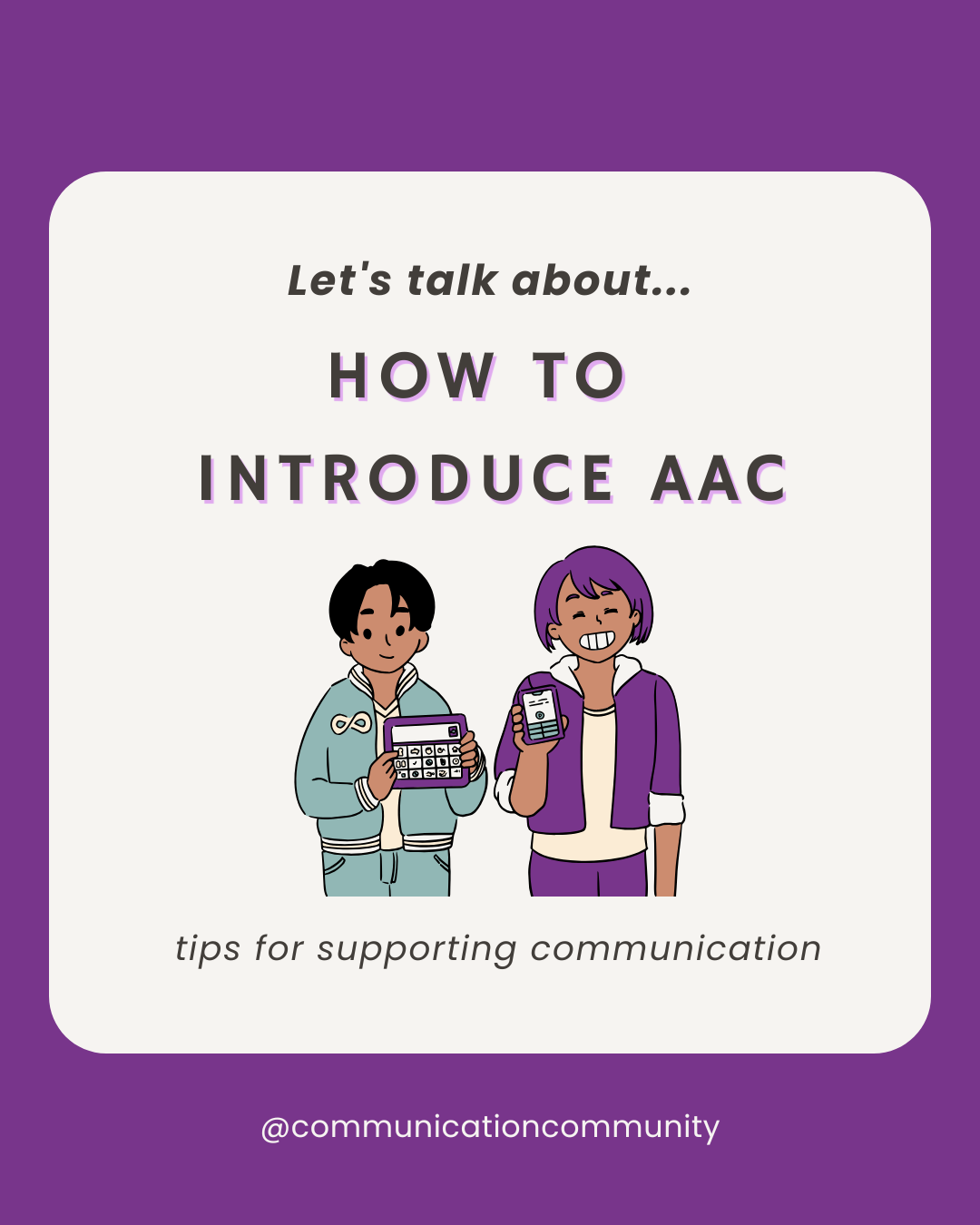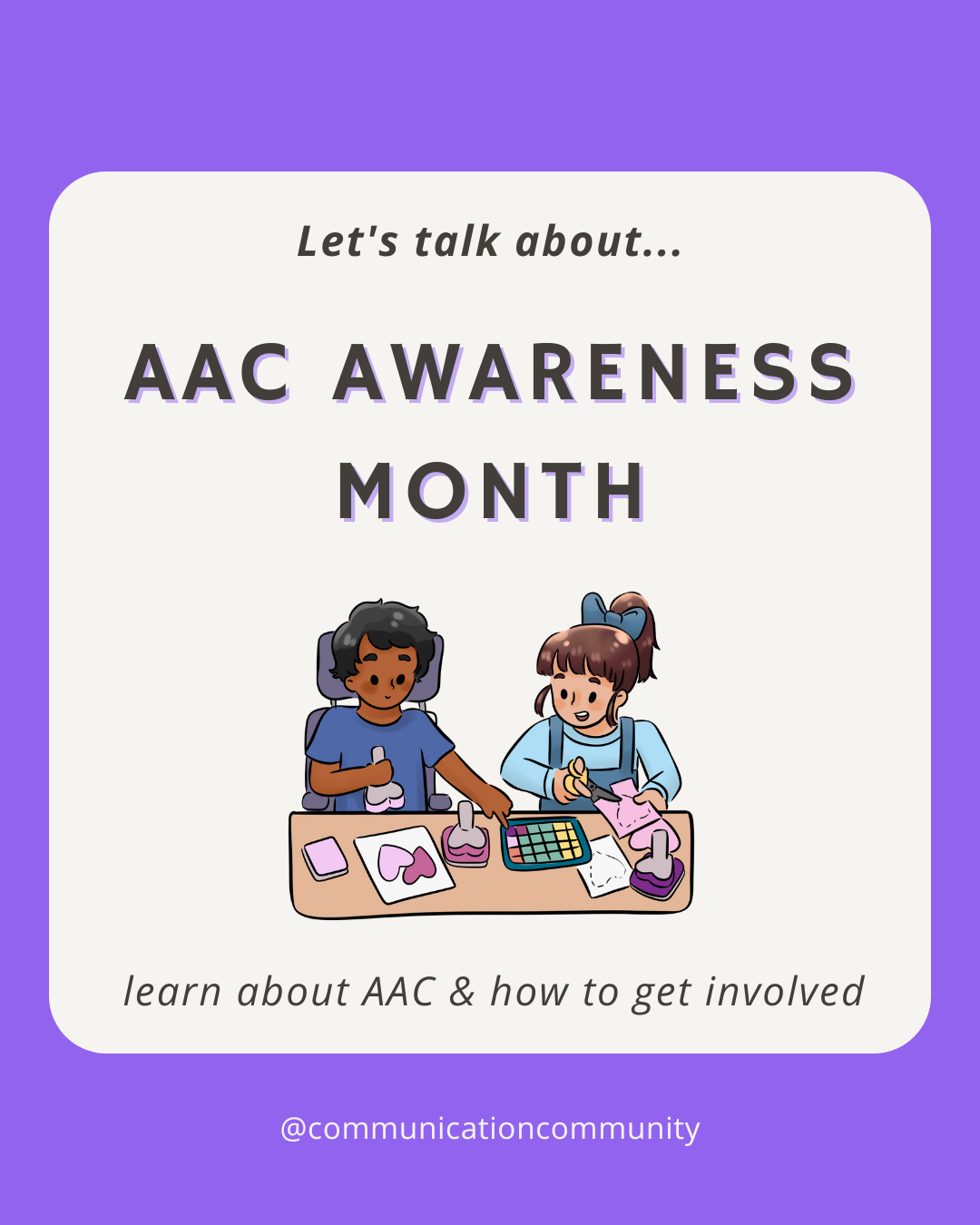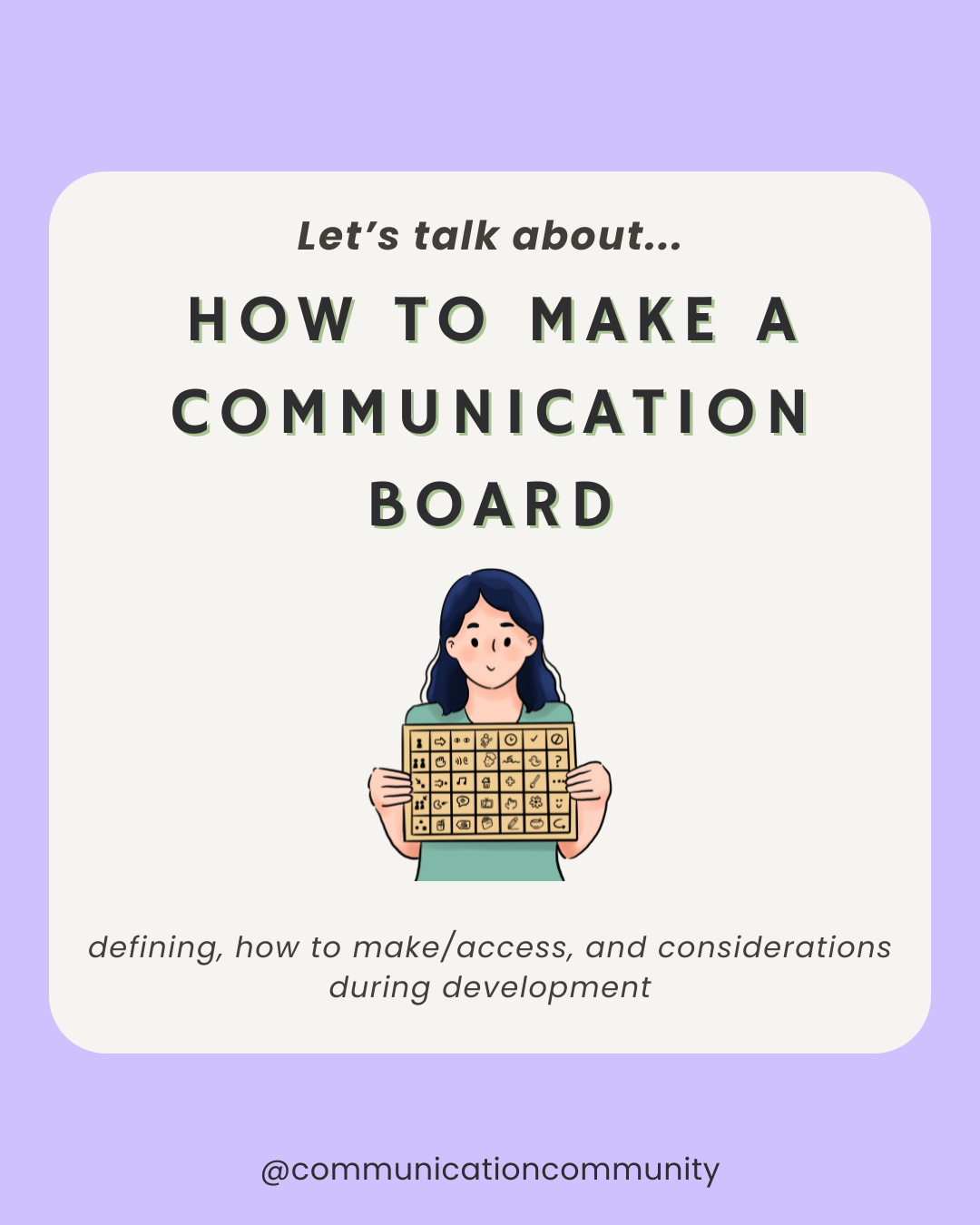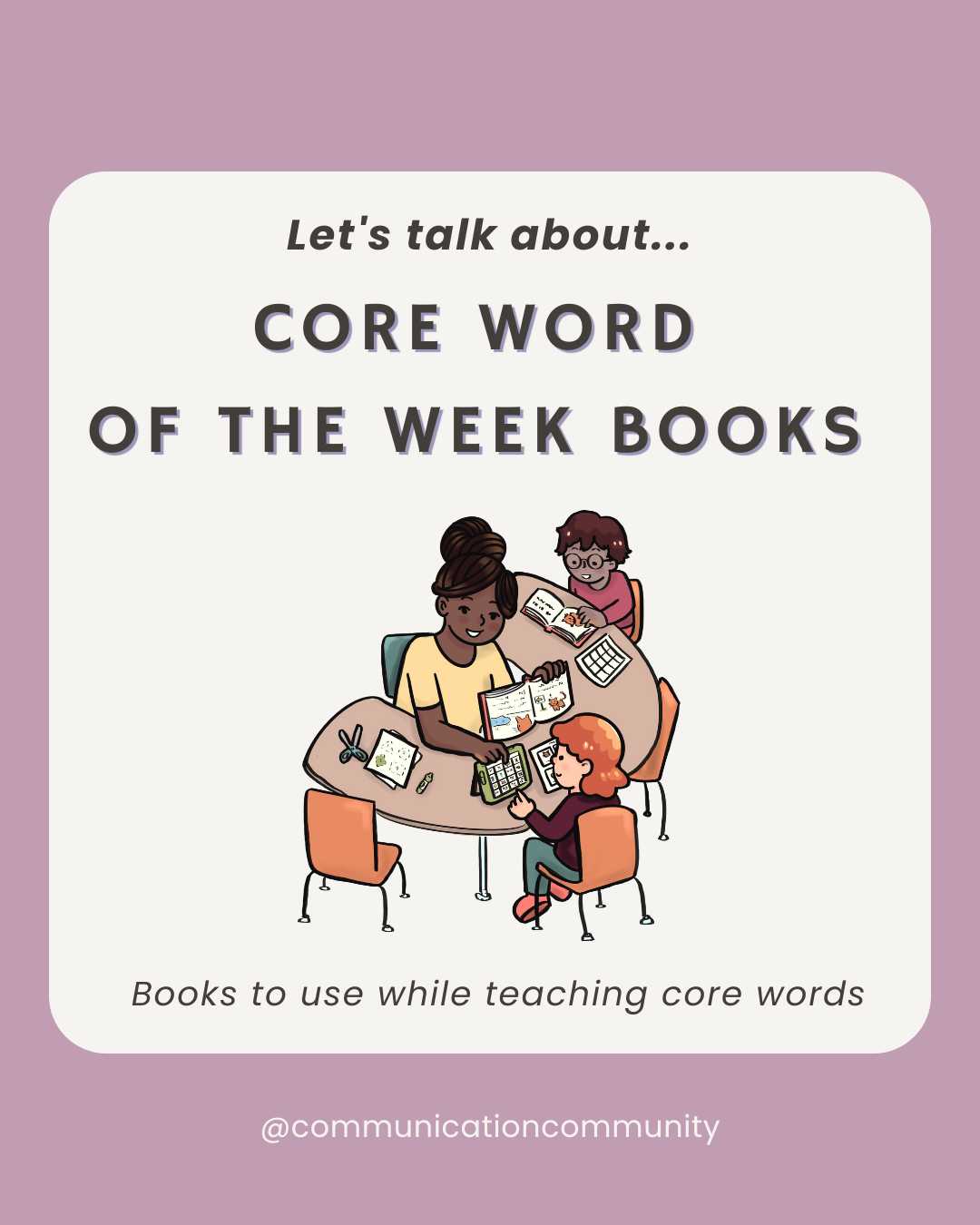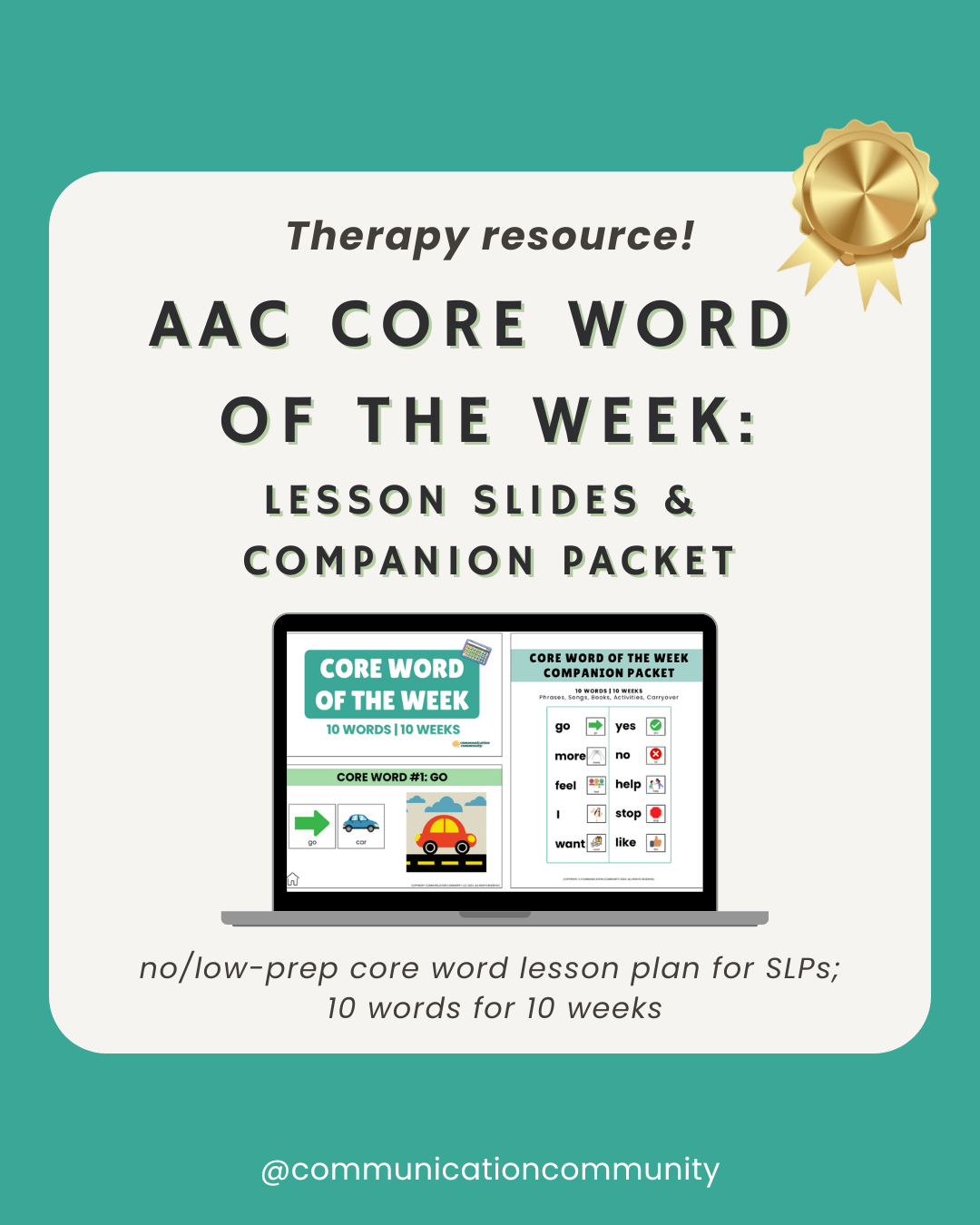This article was last updated on August 22, 2024
Augmentative and alternative communication (AAC) goals are used in speech therapy and written by a speech-language pathologist (SLP).
The purpose of writing goals targeting AAC skills is similar to the overarching goals for all other speech and language areas: to increase functional communication across a variety of individuals, contexts, and settings.
AAC Goals: An Introduction
For many individuals, AAC systems are their primary expressive communication modality. Individuals who use AAC systems (e.g., speech-generating devices/SGDs, communication boards, etc.) may also use other forms of communication, such as verbal language/vocal approximations. As an SLP, targeting skills relating to AAC is incredibly important for any individual who uses an AAC system; as you are helping increase their language use and development. Cue: the importance of goals (and that also means how you write them)!
You may be thinking, okay… so AAC goals should be all about making requests/comments/social exchanges - that’s functional communication right?! That may be one way to look at it, but AAC goals can also expand to other functional (non-linguistic) domains as well! These areas may include operational skills (e.g., [client] will take the AAC system from place to place...) and strategic skills (e.g., [client] will let their communication partner know, “I use my tablet for talking”...). Writing AAC goals for functional, non-linguistic skills can ensure that the AAC user not only can communicate effectively but also can navigate, manage, and personalize their communication tools to fit their lives. This holistic approach to AAC training ultimately supports more meaningful and independent communication.
⭐ Looking for extra AAC resources and support?
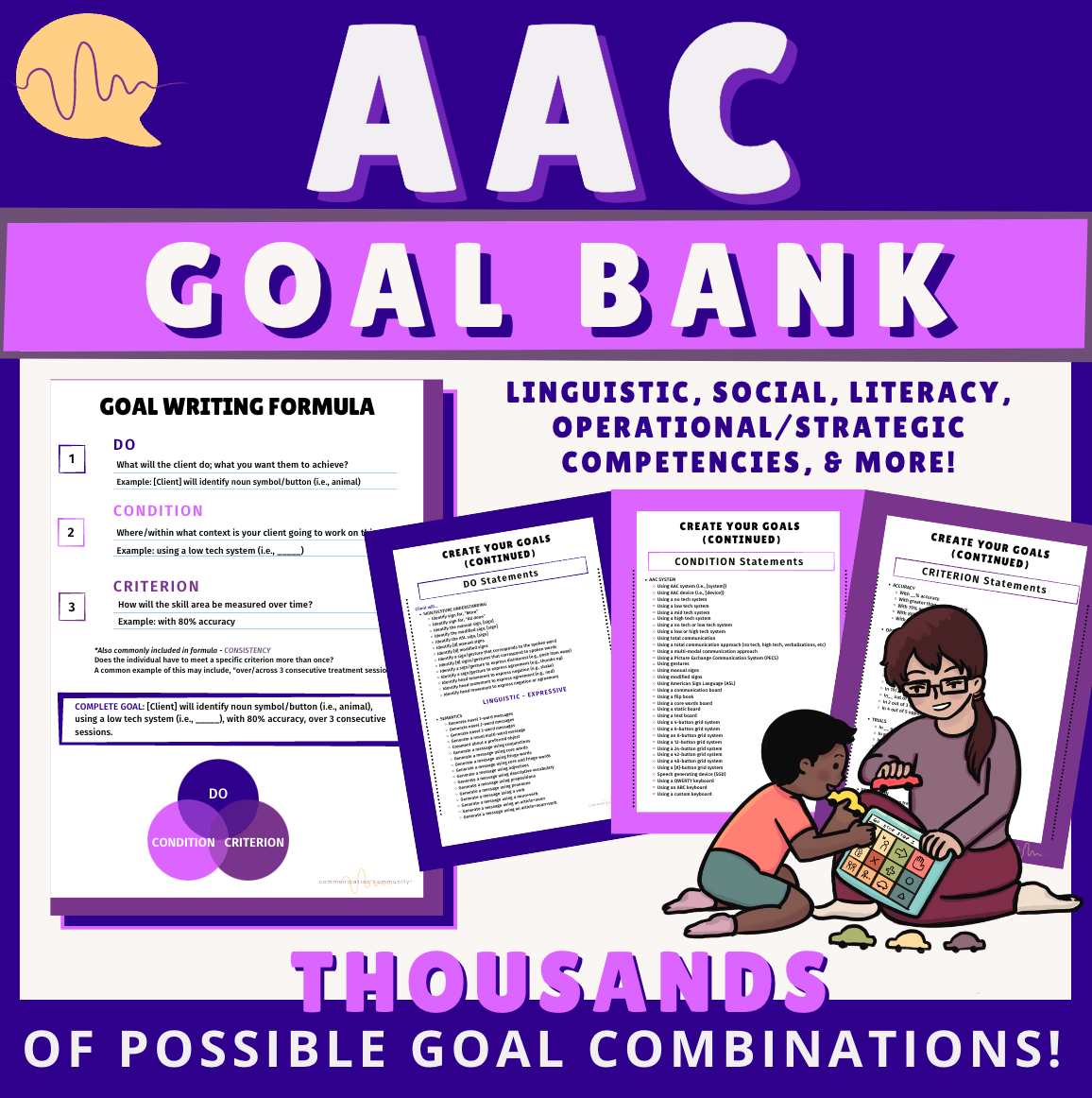
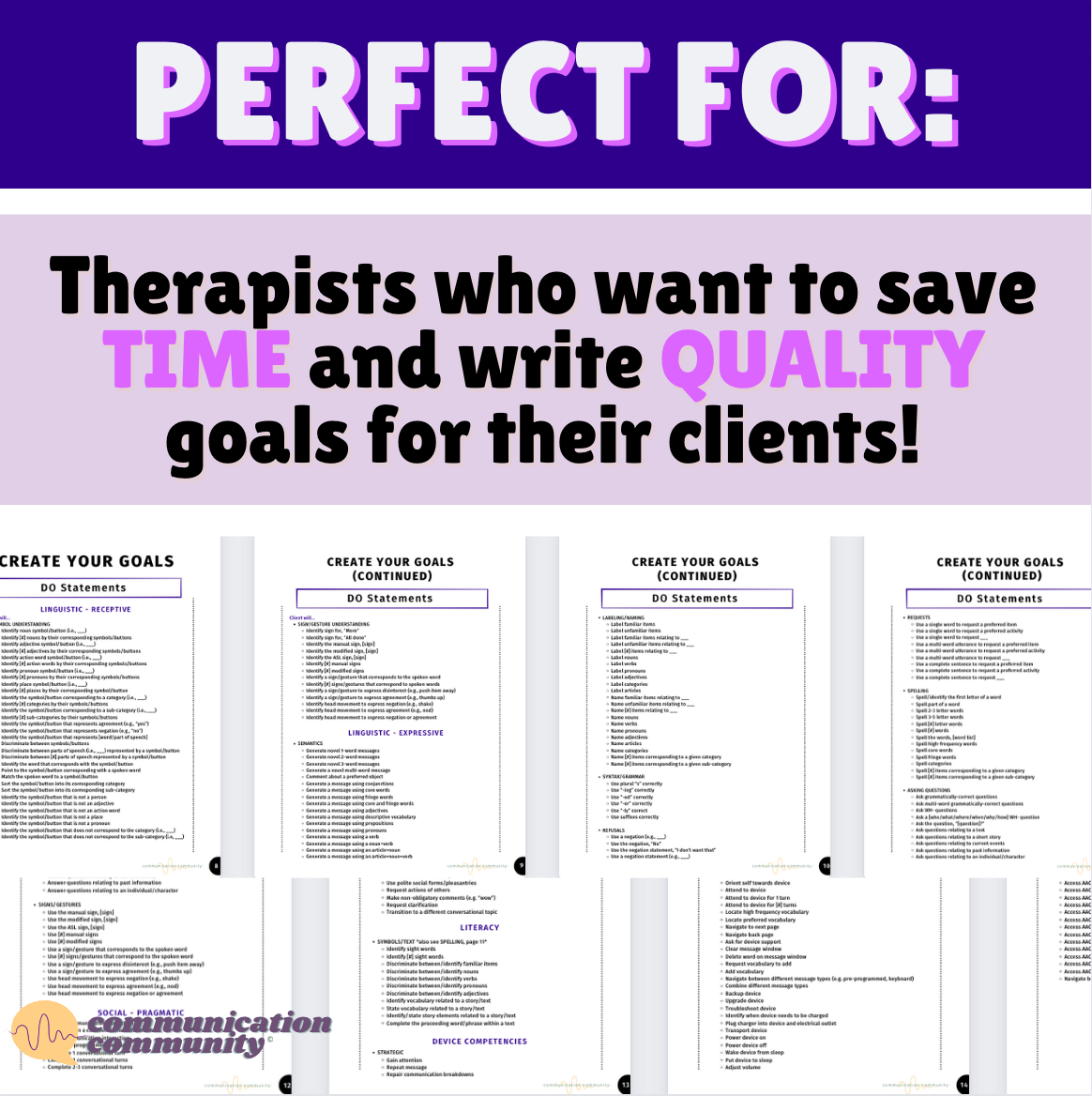
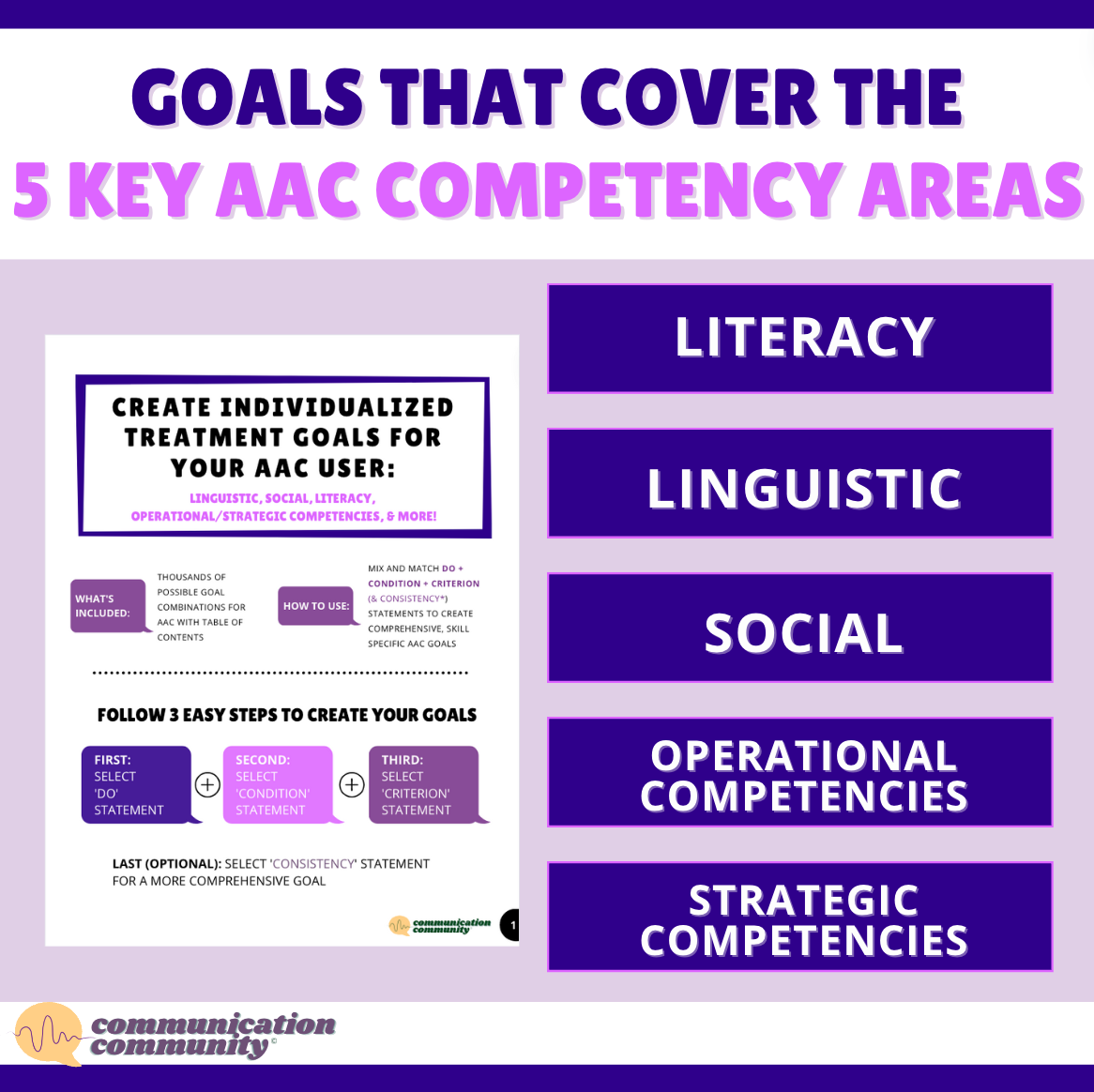
Create measurable and individualized AAC speech therapy goals for your school-aged or adult clients with this top-selling, time-saving resource.

Also available for individual purchase through our TPT and Gumroad stores!
To determine where you should begin with your AAC goals, you will need to conduct some sort of AAC evaluation. This may involve interviews, clinical observations, and/or performing assessments to determine your client's current language skills and their proficiency in navigating/using their AAC system. This will help guide you as you write the most appropriate, evidence-based goals for your client.
Free AAC Assessment Tools*
Clinical observations and interviews with the client, teachers, other therapists, and/or caregivers will give you an indication of how your client uses their AAC system across natural (e.g., at home) and within more structured (e.g., at school) contexts. If your client is new to AAC and you are considering trialing a system, companies such as PRC-Saltillo offer free speech-generating device (SGD) trials with their equipment.
The Tobii Dynavox, Dynamic AAC Goals Grid - 2 (DAGG-2) is an excellent resource that highlights a variety of linguistic components, which can be used when determining different AAC skill areas (think: operational and strategic) to develop goals for.
The Communication Matrix is another tool that is used to record and document an individual’s communication skills over time. Information is gathered from observations and experiences/interactions with the individual using AAC.
*It should be noted that we are not endorsed by any of the following companies mentioned above. There are numerous evaluation tools and resources that can be used to record an individual’s AAC skill level (we just mentioned a few of our go-to's, above). Others include the Functional Communication Profile: Revised, and the low-cost (~$12.99), AAC Evaluation Genie iPad application.
Writing AAC Goals
If you haven’t already, check out our recent article that outlines How to Write Speech Therapy Goals. For the purpose of this article, we will focus specifically on writing goals for increasing AAC skills during therapy.
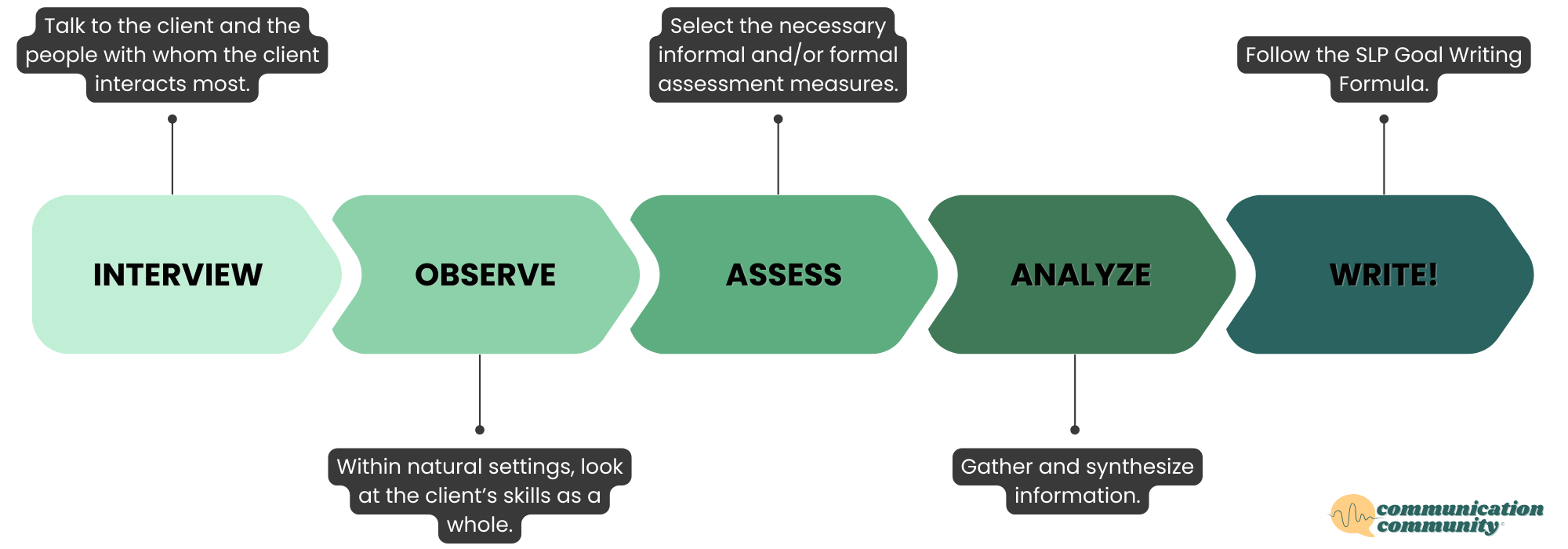
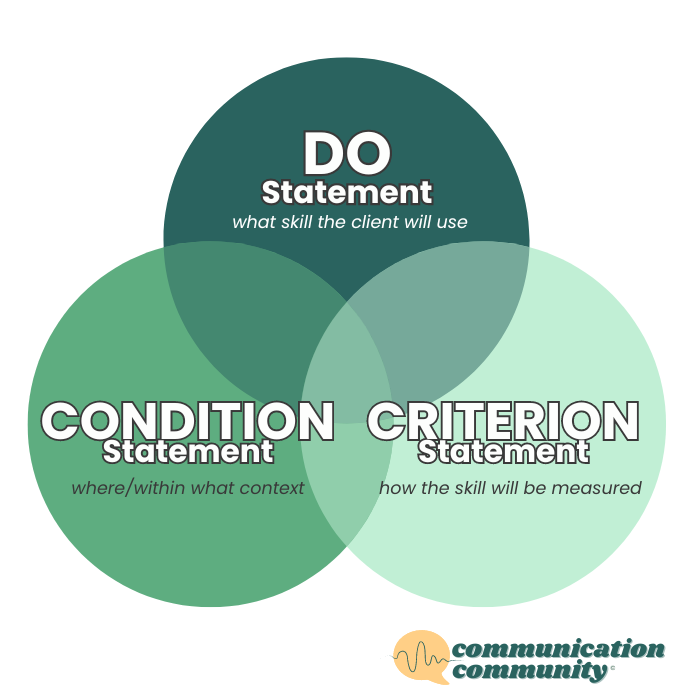
As seen above, speech goals should be written with 3* components in mind: the DO statement, the CONDITION statement, and the CRITERION statement.
*Also commonly included is consistency (we incorporate this!). Aka does the individual have to meet a specific criterion more than once? A common example of this may include across 3 consecutive sessions. This is usually something understood by the therapy organization/service provider and is sometimes/sometimes not included in the written goal itself. This is to ensure that the skill has been generalized and provides more reliable data that the skill has been properly mastered.
DO statement
What the client is actually going to DO and the specific skill they will be working towards.
Example: will use the carrier phrase, “I don’t want [item/activity]”
CONDITION statement
The specific setting and/or context your client will work on this skill.
Example: when expressing refusal for various presented items/activities
CRITERION statement
How the client’s performance will be measured.
Example: in 4 out of 5 opportunities
DO + CONDITION + CRITERION
Example: [Client] will use the carrier phrase “I don’t want [item/activity],” when expressing refusal for various presented items activities, in 4 out of 5 opportunities.
There you have it! An example using our Goal Writing Formula containing the DO + CONDITION + CRITERION (don’t forget to think about consistency!) for a AAC skill areas.
Free AAC Goal Bank
In this post, we have organized our AAC goal examples to fall under some common non-linguistic and (expressively-based) linguistic domains. The most frequently used level of technology is also indicated at the conclusion of the goal.
Important note: the AAC goals shown below are written to acknowledge the principles of modeling without expectation. In summary, modeling without expectation refers to a teaching and interaction approach where the therapist demonstrates the use of AAC methods without demanding an immediate response or specific action from the AAC user. This technique focuses on showing how to use AAC tools in natural, everyday situations, allowing the learner to observe and understand the use of these tools in a pressure-free environment.
It should also be noted that the goal examples provided are NOT designed for one particular linguistic developmental profile (e.g., gestalt language processors, analytic language processors, etc.). Therefore, please use your clinical discretion when selecting goals and treatment targets most suitable for your clients.
AAC: Requesting/rejecting
Example #1: [Client] will use complete phrases (e.g., “I want [item/activity]” or “Can I have [item/activity]?”), to make requests for preferred items/activities during play-based activities, in 4 out of 5 opportunities. High tech (SGD)
Example #2: [Client] will decline a non-preferred/undesirable item using a phrase on their communication board (e.g., "I don't want") and/or other communication modalities, when presented with varied items/activities, with 90% accuracy. Low tech (communication board)
AAC: Sentence construction
Example #1: [Client] will link subject, verb, and nominal to create a simple sentence relating to a preferred topic/activity, within an academically-related activity, with 90% accuracy. High tech (SGD)
Example #2: [Client] will use directives to generate a multi-word utterance (e.g., “go + [subject]”), within a structured game/activity, in 9 out of 10 trials. Mid/high tech (recorded voice output board/SGD)
AAC: Pragmatic/social
Example #1: [Client] will gain an individual's attention and express information about a preferred topic/interest, within unstructured contexts, in 90% of opportunities. High tech (SGD)
Example #2: [Client] will respond to YES/NO questions using any preferred multimodal form of communication, when asked questions related to participation in leisure events, in 4 out of 5 opportunities. Varied tech (gestures, SGD, etc.)
AAC: Self-advocacy
Example #1: [Client] will use the phrase “I need help,” to request assistance within structured/unstructured contexts, in 90% of opportunities. High tech (SGD)
Example #2: [Client] will communicate “more” or “finished,” during/following engagement with an item/activity, in 4 out of 5 trials. Mid tech (switch)
AAC: Operational competency
Example #1: [Client] will adjust volume controls on their AAC system so they can be heard by their communication partner, within a variety of settings (e.g., school or grocery store), within 90% of opportunities. High tech (SGD)
Example #2: [Client] will charge their AAC system, when presented with a battery life of <5% across settings, within 90% of opportunities. High tech (SGD)
AAC: Strategic competency
Example #1: [Client] will use a repair strategy (e.g., repeat or rephrase message) in the event of a communication breakdown, when engaged in a conversational exchange, within 90% of opportunities. High tech (SGD)
Example #2: [Client] will use an introductory phrase (e.g., “I use my tablet for talking”) before communicating their message, when conversing with a communication partner, within 90% of opportunities. High tech (SGD)
As you can see above, some of the goals are written very specifically and some are slightly broader - both are OKAY! Sometimes, AAC users may benefit most from goals that are adaptable based on their changing needs and communicative preferences (e.g., including multimodal forms of communication in the DO/CRITERION statement).
Looking for more information about goals and goal banks?
Check out some of our other posts:
- How to Write Pragmatic Language Goals
- How to Write Receptive Language Goals
- How to Write Play Skills Goals
- How to Write Expressive Language Goals
- How to Write Early Intervention Goals
References/further resources:
http://tdvox.web-downloads.s3.amazonaws.com/MyTobiiDynavox/dagg%202%20-%20writable.pdf

![How to Write AAC Goals [with goal bank]](https://www.communicationcommunity.com/content/images/2024/03/How-to-Write-AAC-Goals---ghost-cover.png)
